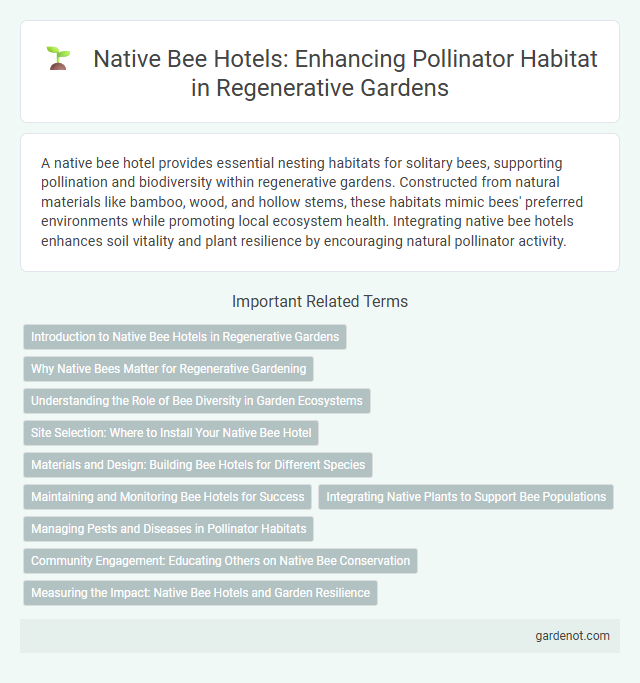A native bee hotel provides essential nesting habitats for solitary bees, supporting pollination and biodiversity within regenerative gardens. Constructed from natural materials like bamboo, wood, and hollow stems, these habitats mimic bees' preferred environments while promoting local ecosystem health. Integrating native bee hotels enhances soil vitality and plant resilience by encouraging natural pollinator activity.
Introduction to Native Bee Hotels in Regenerative Gardens
Native bee hotels provide essential habitats for solitary bees, supporting biodiversity and pollination in regenerative gardens. These structures mimic natural nesting sites, such as hollow stems and wood tunnels, offering refuge for native bee species that are crucial for maintaining ecosystem health. Incorporating native bee hotels enhances garden resilience by promoting healthy bee populations and increasing pollination efficiency for native plants.
Why Native Bees Matter for Regenerative Gardening
Native bees play a crucial role in regenerative gardening by enhancing pollination efficiency, leading to healthier plants and increased crop yields. Their diverse species are specifically adapted to local ecosystems, promoting biodiversity and supporting resilience against pests and climate stress. Installing native bee hotels provides essential nesting habitats, ensuring the survival of these vital pollinators and sustaining ecological balance.
Understanding the Role of Bee Diversity in Garden Ecosystems
Native bee hotels create essential habitats that support diverse bee species, enhancing pollination and overall garden health. High bee diversity boosts plant reproduction, resilience to pests, and ecosystem stability by ensuring a variety of pollination behaviors and flowering time coverage. Incorporating bee hotels in regenerative gardens promotes sustainable biodiversity and strengthens local food webs by attracting solitary and specialized native bees.
Site Selection: Where to Install Your Native Bee Hotel
Choose a dry, sheltered spot with plenty of sunlight, ideally near native wildflowers and flowering shrubs that provide nectar and pollen. Position the native bee hotel at least 3 feet off the ground to protect it from predators and moisture. Avoid locations exposed to strong winds or heavy rain to ensure a safe, stable habitat supporting native bee populations.
Materials and Design: Building Bee Hotels for Different Species
Using natural materials like untreated wood, hollow stems, and bamboo creates ideal habitats in native bee hotels, catering to solitary bee species such as mason and leafcutter bees. Designing varying tunnel diameters and depths accommodates diverse bee sizes and nesting preferences, enhancing species-specific attraction and occupancy rates. Incorporating weather-resistant materials and proper drainage ensures durability while protecting bee larvae from moisture-related threats.
Maintaining and Monitoring Bee Hotels for Success
Regularly inspecting native bee hotels ensures the habitats remain clean and free from mold, parasites, or predators that can harm bee populations. Maintaining proper moisture levels and replacing damaged or occupied nesting materials supports successful bee reproduction and biodiversity. Monitoring occupancy rates and species diversity provides valuable data to optimize hotel placement and design for regenerative garden ecosystems.
Integrating Native Plants to Support Bee Populations
Integrating native plants in a regenerative garden creates essential habitats and food sources for native bee populations, enhancing biodiversity and pollination efficiency. Native bee hotels placed near these plants provide shelter and nesting sites, supporting the lifecycle of local pollinators. This synergy fosters a resilient ecosystem, promoting sustainable garden health and increased crop yields.
Managing Pests and Diseases in Pollinator Habitats
Native bee hotels support microbial diversity that naturally controls pests and diseases in pollinator habitats, reducing the need for chemical interventions. Regular cleaning and replacing old nesting materials prevent buildup of parasites like Varroa mites and fungal infections such as chalkbrood. Integrating native flowering plants nearby enhances habitat resilience, attracting beneficial insects that prey on common pollinator pests.
Community Engagement: Educating Others on Native Bee Conservation
Native bee hotels serve as vital educational tools that promote community engagement by raising awareness about native bee conservation. These structures provide a hands-on opportunity for local residents to learn about native bee habitats, their role in pollination, and the importance of preserving biodiversity. Hosting workshops and interactive demonstrations around native bee hotels fosters stewardship and mobilizes community support for regenerative gardening efforts.
Measuring the Impact: Native Bee Hotels and Garden Resilience
Native bee hotels enhance garden resilience by providing essential habitats for pollinators, directly increasing biodiversity and improving plant health. Measuring the impact involves tracking pollinator visitation rates, nesting success, and plant reproduction outcomes to assess ecosystem benefits. Studies show gardens with native bee hotels experience higher pollination efficiency, leading to stronger, more sustainable regenerative landscapes.
Native bee hotel Infographic

 gardenot.com
gardenot.com